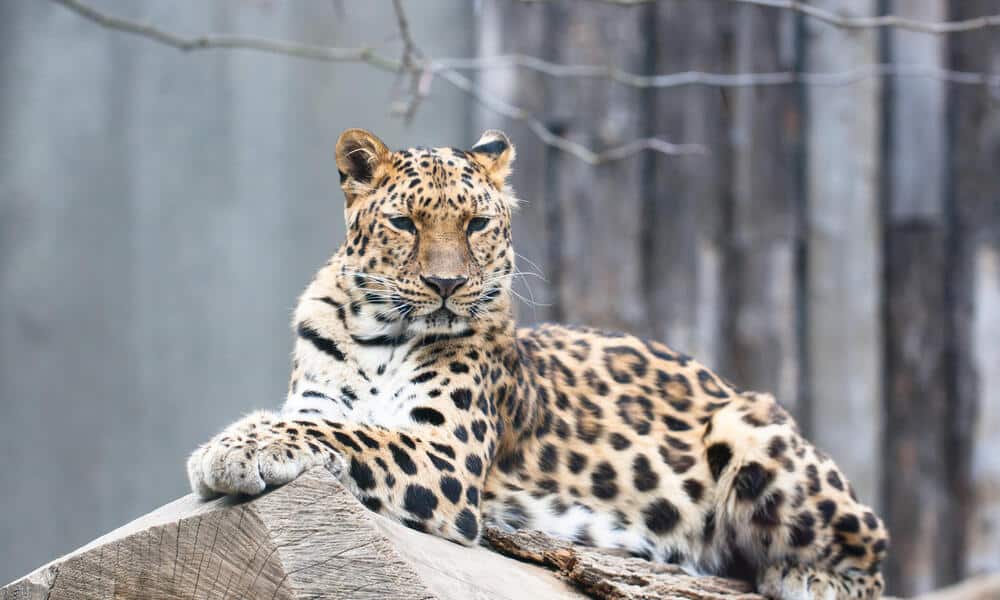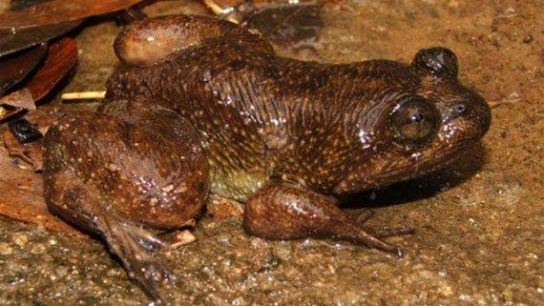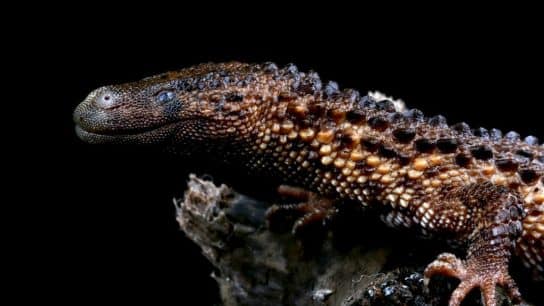The Amur Leopard, also known as the Far East leopard, the Manchurian leopard, or the Korean leopard, is one of nine extant subspecies of leopard (Panthera pardus). Native to the Russian Far East, Northern China and the Korean Peninsula, Amur leopards have developed several morphological adaptations to withstand the often harsh climates of the high-altitude, temperate forests they inhabit. Believed to have once sustained large, widely distributed populations across its endemic range states, the Amur leopard began suffering extensive populations declines in the 1970s as a result of poaching, habitat loss, and reduced availability of prey. With just over 100 individuals remaining, the subspecies faces an extremely high risk of extinction without the implementation of effective conservation measures.
—
Family: Felidae
Genus: Panthera
Species: Panthera pardus
Subspecies: Panthera pardus orientalis
IUCN Status: Critically Endangered
Population: Over 100 individuals
1. Appearance
Renowned for their ability to adapt to various terrains, climates and habitats, Amur leopards have developed a number of physiological adaptations to survive at significantly colder temperatures than their African counterparts. Although they are slightly smaller than other leopard subspecies, with males weighing approximately 32 to 48 kilograms and females roughly 25 to 43 kilograms, Amur leopards have longer, stronger limbs and wider paws for climbing trees and walking through deep snow. As with all cats, their claws are fully retractable, protected by a sheath of skin to prevent them from becoming dull or damaged when not being used to hunt, climb, provide traction or scratch. They have also been observed wrapping their tails, which average a length of approximately 80 centimetres, around their bodies to keep warm.
Amur leopards sport thicker, paler-coloured coats than other leopard subspecies, which change in shade and length depending on the season. During the summertime, the Amur leopard’s fur has been described as a vivid, rusty reddish-yellow, not exceeding 2.5 centimetres in length. During the winter months, the subspecies coat becomes a lighter, softer shade of yellow and grows to approximately 5 to 7 centimetres in length. The rosettes that adorn the Amur leopard’s fur are more widely spaced and have thicker black borders than those of other subspecies. As this iconic spotted pattern is unique to each individual leopard, in the same way that fingerprints are unique to each individual human, it is an important tool utilised for individual and species recognition.
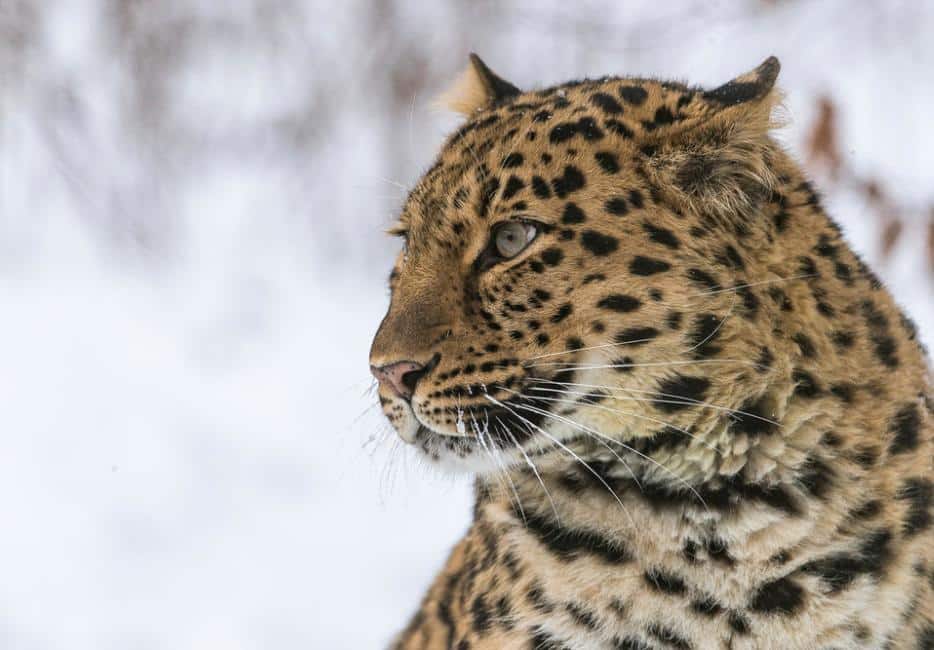
Amur leopards have thicker, denser coats than their African counterparts (photograph courtesy of WWF).
2. Diet
The Amur leopard is a strictly carnivorous, highly-skilled predator. Known amongst scientists as the “silent killer”, Amur leopards are widely regarded as the most accomplished stalkers and arboreal climbers of the big cats, tackling prey up to ten times their own weight. Their prey typically consists of ungulates, such as Manchurian sika deer, Siberian roe deer, and Ussuri wild boar; although the subspecies has been observed occasionally or opportunistically hunting smaller mammals, such as weasels, rabbits, badgers, birds and mice. As such, Amur leopards are typically crepuscular hunters, active mostly at dawn and dusk. Any unfinished kills are typically carried up and stored on high branches on trees to avoid being stolen by other predators. Due to the carnivorous nature of their diet, Amur leopards have also developed specialised papillae (small, sharp bumps) on their tongue, which aid with scraping the meat off the bones of their prey.
3. Habitat, Behaviour & Evolution
Once distributed across Northern China, the Russian Far East and the Korean Peninsula, remaining Amur leopard populations are currently located in three key regions: Primorsky Krai in Russia, and the provinces of Jilin and Heilongjiang in China. The last Amur leopard sighting in South Korea was recorded in 1969, whilst the presence of the subspecies in North Korea remains unknown. Although left with a residual area of suitable habitat between 2,500 and 5,000 square kilometres in size, approximately 70% of this range is located within protected areas and has the capacity to support a larger population of Amur leopards than is currently held.
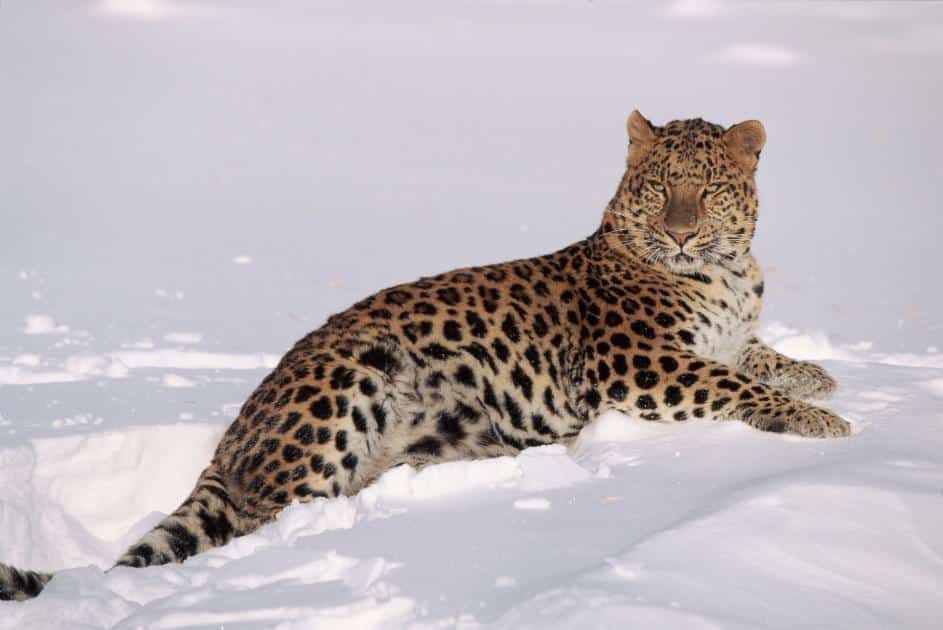
Amur leopards have longer, stronger limbs and wider paws for walking through snow (photograph courtesy of WWF).
Primary Amur leopard habitat is defined by middle-elevation, Manchurian mixed forests of Korean pine conifers and deciduous Mongolian oak. The subspecies tends to avoid open, populated grassland areas, instead opting for rugged hills, rocky outcrops and watersheds. During winter months, the subspecies keeps to southern-facing rocky slopes to avoid heavy snowfall. The territorial range of each individual leopard depends largely on the age and sex of the animal, as well as the prey density of the area, and can span from 50 to 310 square kilometres. Nocturnal and solitary by nature, Amur leopards are adept climbers and can camouflage well within trees. Like other leopard subspecies, they can run at speeds of 60 kilometres per hour, climb up to 15 metres high, and leap 6 metres horizontally and 3 metres vertically.
Reaching sexual maturity at the age of two and a half to three years, Amur leopards typically breed during the second half of winter. After a gestation period of 90 to 95 days, litters of two to three cubs are usually born from March to May, covered in thick, long fur. Amur leopard kittens are extremely vulnerable during their first weeks of life: born blind, weighing approximately 500 to 700 grams, and unable to crawl until 12 to 15 days after brith. As such, a litter will stay with their mother for up to two years, with some siblings further remaining together during the first years of independence. Nevertheless, mortality rates remain high amongst young leopards due to the unforgiving conditions of their native habitat. Whilst wild Amur leopards have a life expectancy of 10 to 15 years, their captive counterparts can live up to 20 years.
4. Services
Despite their elusive nature, as well as their remote and relatively limited geographical range, Amur leopards play an incredibly important role in the sustaining the ecological vitality of their surrounding environment. As the subspecies is widely considered to be an apex predator within their natural habitat, consuming a wide variety of prey throughout the year, they consequently aid in maintaining healthy levels of species density. As a number of the Amur leopard’s preferential prey are herbivorous and omnivorous, the population control service provided by these skilled hunters therefore affects the health of the forests they, as well as a myriad of other plant and animal species, depend on. The increasing global awareness garnered by the Amur leopard’s plight, and the resulting conservation efforts implemented for their protection, also assist a number of neighbouring species facing similar threats of habitat loss and degradation.
5. Threats
Listed as ‘Critically Endangered’ by the International Union for Conservation of Nature (IUCN) since 1996, the Amur leopard suffered extensive population declines in the late 20th century as a result of poaching, habitat loss and degradation, prey depletion, and a number of consequential anthropogenic threats. Now left with a meagre relict population, which is substantially lacking in genetic diversity and struggles to be quantified with any degree of certainty, the subspecies faces a distinct possibility of extinction.
Despite numerous national and international laws prohibiting the hunting of Amur leopards, with the subspecies listed under Appendix I of the Convention on International Trade in Endangered Species of Wild Fauna and Flora (CITES), poaching continues to pose a threat to remaining populations in both Russia and China. In an investigation conducted in 1999, undercover teams seized two Amur leopard pelts, one female and one male, which were priced at US$500 and US$1000 respectively. The pelts were sold in the village of Barabash, Russia, and were believed to have originated from the Kedrovaya Pad reserve. In 2009, police officers confiscated an Amur leopard skin found in a car in the Primorsky province of the Russian Far East, and in 2013 a dealer was apprehended with an Amur leopard pelt in his possession in Vladivostok. Although no further reports of pelt seizures have arisen in the last decade or so, difficulties with regulating Amur leopard populations surrounding remote villages, particularly those in non-protected areas in close proximity with the Sino-Russian border, pose a challenge to preventing the illegal wildlife trade in such regions. Apart from being poached for their fur, leopard bones hold high financial value in traditional Asian medicinal practices, particularly in China where the bones are steeped in rice wine to produce health tonics and other unsubstantiated remedies for an array of medical problems.

An Amur Leopard pelt confiscated by police in the Primorsky province of Russia (photograph courtesy of S. Aramilev for WWF Russia).
Extensive habitat loss and degradation, which increased dramatically in the 1970s as a result of logging, agriculture, forest fires and overpopulation, further facilitated the hunting of Amur leopards as roads, infrastructure development, and the clearing of forests exposed the subspecies to human settlements. Scientists estimate that between 1970 and 1983, approximately 80% of primary Amur leopard habitat was lost due to anthropogenic factors. Between 1949 and 1986, northeastern China produced an estimated 658 million cubic metres of timber to serve as construction material within the country, whereas in Russia, 3,426 square kilometres, or 46%, of potential Amur leopard habitat was deliberately burned between 1996 and 2003 (12 to 22% of which continues to be burned on an annual basis). Further infrastructure development projects, such as gas pipeline plans, road and railway network construction, electricity grid expansion, and coal or mineral extraction, continue to deplete and degrade the little habitat Amur leopards retain.
This rampant loss of habitat, paired with the ever-expanding human population, has also placed an immense strain on sources of sustenance for the Amur leopard, as preferred species of prey have gradually become scarce in certain regions. Not only must the subspecies compete with fellow apex predators, such as Amur tigers, for free-roaming deer, boar and hares; villagers and farmers living in settlements surrounding prime leopard habitat also depend upon these prey species for their survival. As a result, Amur leopards have been observed preying upon domesticated animals, livestock, and farmed deer, rendering them vulnerable to often fatal human conflicts. Exposure to both feral and domesticated dogs, as well as wild sable, racoon dogs, and Asian badgers, also pose a threat to Amur leopards as reports of canine distemper in the subspecies have arisen both in the past (1993 to 1994) and as recently as 2015.
As a consequence of the Amur leopard’s drastic population decline over the past 50 years, difficulties associated with a critically low wild population size, such as vulnerability to disease and catastrophes, unpredictable variation in birth and death rates and sex ratios, as well low genetic diversity, have begun afflicting the remaining population. Biomedical examinations conducted by the Wildlife Conservation Society on three Amur leopards in 2006 indicated early signs of health problems associated with inbreeding: all three leopards were found to have significant heart murmurs, and one had over 40% abnormal sperm production. Although more research is necessary to fully understand the effects of inbreeding on the subspecies, common risks include fertility issues and a decrease in the genetic health and fitness of newborn leopards. According to studies conducted on Amur leopard litters, the number of cubs born per adult female decreased from 1.9 in 1973 to 1 in 1991. Whilst father-daughter and sibling matings have been observed naturally (to a certain extent) in large cat species, the Amur leopard’s extremely small population size prevents the possibility of subsequent outbreeding. With the increasing prevalence of unpredictable climate events having a significant effect on the Amur leopard’s natural habitat, weak genetic diversity limits the subspecies’ ability to adapt to further environmental changes in the future.
You might also like: 10 of the World’s Most Endangered Animals in 2022
6. Conservation
Due to the sheer extent of the Amur leopard’s plight, having been driven to the edge of extinction by the start of the 21st century, teams of national and international conservationists, governments and scientists have implemented and maintained a number of strategies for the subspecies’ protection that have ultimately resulted in promising population increases in recent years.
In 2001, an International Workshop on the Conservation of the Far Eastern Leopard was conducted in Vladivostok, in which scientists and government authorities proposed a drastic plan to capture the remaining Amur leopard population and retain it in captivity, thereby securing their survival for future breeding and reintroduction attempts. However, the Russian government instead began to lay the foundations for a new protected area for Amur leopards, which ultimately led to the formation of Land of the Leopard National Park in 2012. The park covers approximately 2630 square kilometres and comprises 60% of the Amur leopard’s remaining habitat. Since its inception, the population of leopards within the park’s boundaries has tripled to 84 adults and 19 cubs or adolescents, marking the first time in decades that the subspecies population has exceeded 100 individuals. Not only have government and park officials worked to remove anthropogenic pressures that primarily threatened remaining leopard populations, such as the establishment of a 450 metre-long tunnel beneath a major motorway to aid leopard migration, the reforestation of land previously utilised for livestock grazing and agriculture, and the implementation of anti-poaching patrols across the park’s range; a significant improvement in monitoring and counting methods has also allowed scientists to calculate population sizes with greater accuracy, determining the presence of mating females and newborn cubs through an analysis of the fur patterns of leopards caught on camera. With a network of 400 cameras spread across 3600 square kilometres, park officials no longer rely on locating paw prints in snow and can track populations as they disperse past park boundaries and across the border with China.
Similar initiatives have been implemented in China with comparably promising increases in Amur leopard numbers. In addition to the founding of three protected nature reserves – Hunchun, Wangqing and Huangnihe – near the borders China shares with North Korea and Russia, the provincial government of Jilin has actively rejected or ordered the redesign of infrastructure project proposals which potentially pose a threat to Amur leopard and tiger populations. These include the construction of a highway, as well as a high-speed railway connecting Hunchun City with Vladivostok. In 1998, the National Forest Protection Programme (NFPP) was established with the aim of restricting rampant logging practices, and in 2015 a complete prohibition on commercial logging was implemented by the province of Jilin. As a result, the Forestry Department of Jilin reported that forest coverage in the region had risen to nearly 44%, or 93.86 billion square kilometres. An expansion on forest patrols and snare-removal campaigns further allowed for the clearing of 8,250 wire snares within the Hunchun National Nature Reserve between September 2015 and January 2016, as well as the apprehension of 314 poachers by Jilin government officers. In 2006, the Jilin provincial government introduced a compensation programme for local farmers and livestock herders in an effort to prevent retaliatory acts or human conflicts which commonly result in wildlife fatalities. Since its inception, the government has spent USD 18 million on 37,000 compensation cases in the region, covering 100% of the market value of produce or livestock preyed upon by Amur leopards and tigers.
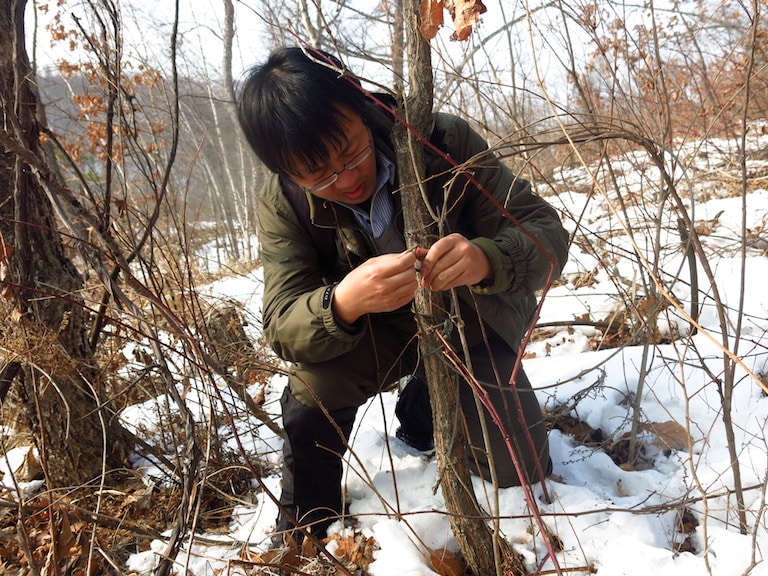
The Global Protected Area Friendly System, an NGO based in China, have cleared thousands of poaching snares in Hunchun Nature Reserve (photo courtesy of Global Protected Area Friendly System).
Despite the well-documented fact that Amur leopards typically cross between the Sino-Russian border, Russia and China remained relatively independent in establishing conservation strategies for their respective leopard populations until recently. In 2017, researchers from Beijing Normal University proposed the creation of a new transboundary national park, spanning 14,600 square kilometres, which would essentially combine the Northeast Tiger and Leopard National Park in China with the Land of the Leopard National Park and Kedrovaya Pad Nature Reserve in Russia. Initially commencing as a pilot project, the park has since allowed for the sharing of scientific research and data collected from camera traps and monitoring activities by both nations, resulting in the creation of an unprecedentedly extensive survey of the transboundary leopard population and a stronger understanding of the ecological requirements for their protection.
Nevertheless, concerns have arisen with regards to the seemingly economic and touristic motives behind the Chinese government’s national parks programme. Scientists and conservationists have stressed the importance of enacting rigid legal protections for newly established parks in order to prevent any commercial infrastructure or development pressures in the long run. China faces further difficulties with the approximately 100,000 locals residing in or around the national park, as many rely on agriculture and livestock cultivation for sustenance and income. Although the local government plans to relocate villages and communities located within park boundaries to avoid conflicts with wildlife, solutions for the consequential financial burden on farmers and cattle herders have not yet been announced.
Another critical contributor to the protection of Amur leopards has been the scientific community, as conservation strategies implemented by local and national governments in China and Russia have been largely informed by the research and findings of national and international scientists. In China, studies utilising gazetteers, or local records, have provided insights into the ecological, biogeographical, economic and political characteristics of Amur leopard population declines, as well as allowing for a reconstruction of the subspecies’ historical population dynamics. Such information is expected to assist in the creation of effective, well-informed conservation strategies and for long-term population management, as it provides a stronger understanding of the optimal ecological conditions necessary for the Amur leopard’s survival in the wild.
Discussions have also arisen for the introduction of a second Amur leopard population into the subspecies’ former territorial range, intended to improve the genetic diversity of existing wild Amur leopards and thus reduce the risk of inbreeding depression or extinction from catastrophic events. However, this has been an area of contention, as captive Amur leopard populations appear to have been accidentally hybridised (deriving their gene flow from both Panthera pardus orientalis and Panthera padrus japonensis, a neighbouring subspecies), with some arguing that their introduction into the wild would threaten the integrity of a morphologically and genetically unique subspecies if they were to breed. However, many instead maintain that captive populations should be regarded as beneficial for wild populations, as they would augment the genetic diversity of homogenised wild leopards, thus enhancing their fitness and ability to withstand shifts in environmental conditions. A similar approach was successfully utilised for the restoration of the Florida panther, which was faced with the threat of extinction having suffered extensive population declines.

Captive Amur leopards at the Colchester Zoo. There are around 200 Amur leopards in captivity, mostly in zoos across North America, Europe, and former Soviet Union states (photo courtesy of the Colchester Zoo).
In addition to the conservation efforts undertaken by government officials and the scientific community, a number of international NGOs, such as the World Wide Fund for Nature (WWF), have played a critical role in supporting and supplementing national protection strategies. In collaboration with TRAFFIC, the largest wildlife trade monitoring organisation, WWF assists in implementing anti-poaching and environmental education programmes in known leopard habitats, as well as aiding governments in enforcing national and international bans on the trade of leopard products. WWF further works with companies to commit to responsible forestry practices, whilst striving to prevent illegal or unsustainable logging in both Russia and China. In 2007, the organisation, together with other conservationists, successfully lobbied the government of Russia to redesign the routing of an oil pipeline which would have posed a threat to Amur leopard habitat. WWF has further aided with monitoring leopard populations across Russia and China’s national parks, supplying camera traps for more accurate population counts, whilst also supporting the rebuilding of leopard prey populations through the release of deer and boar into reserves.
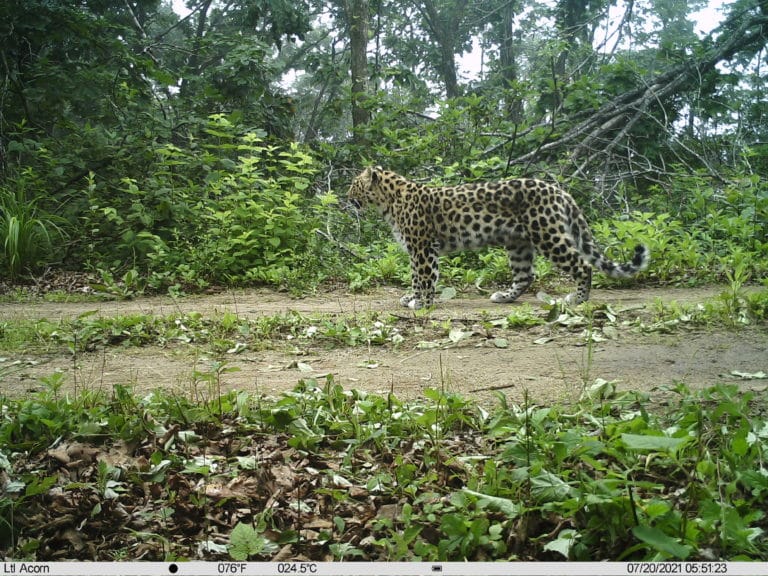
Amur leopard captured on camera at the Hunchun Nature Reserve (photo courtesy of the WildCats Conservation Alliance).
NGO Spotlight: WildCats Conservation Alliance
The WildCats Conservation Alliance (WCS), an initiative of the Zoological Society of London (ZSL) and Dreamworld Wildlife Foundation (DWF), is another NGO providing critical support in the conservation of the remaining Amur leopard population. In China, surveys conducted by the WCS in 2001 were instrumental in the establishment of the Hunchun Nature Reserve, and the organisation has since continued to assist with snare removals, patrol strategy planning, ecological monitoring, camera trap placement and maintenance, and in minimising human-wildlife conflicts. More recently, the WCS aided in the management of the new Tiger and Leopard National Park, proposing conservation priorities and organisational strategies. Within Russia, the WCS has introduced SMART (Spatial Monitoring and Reporting Tool) into national parks with the aim of reducing instances of poaching through improved monitoring and data analysis methods. The tool provides park rangers with quantitative and geographically-referenced information for the enforcement of anti-poaching laws, particularly in areas where limited government funding has had an impact on the efficiency of patrol efforts. Education campaigns and extra-curricular programmes aimed at teaching children the ecological importance of protecting wildlife and the environment are hoped to further prevent instances of poaching through the creation of an environmentally-conscious generation of students. To date, the WCS has raised over USD 4.6 million in support of 103 monitoring, conservation, conflict resolution, environmental protection and awareness-raising campaigns and projects.
How to Help
- Support an NGO. There are several national and international NGOs that are working hard to implement conservation strategies for the protection of Amur leopards, such as the WildCats Conservation Alliance. You can assist their efforts by donating funds, raising awareness, or hosting a fundraiser.
- Cut down on your paper and plastic use. As mentioned, logging is a major threat to Amur leopards in China and Russia. Reduce the amount of paper and plastic you purchase, and recycle any that you do.
- Boycott the illegal wildlife trade. Whilst it may seem like an obvious solution, steady consumer demands indicate that many continue to purchase fur, skins and other products derived from endangered wildlife species. If you know anyone who uses or possesses such products, let them know of the consequences of participating in the illegal trade, both legal and ecological.
Featured image: Courtesy of WWF
If you enjoyed this article, check out the other stories on our Endangered Animals Spotlight Page










